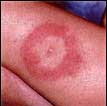Lyme Disease
In our area of Southern
California, Lyme Disease has not taken hold like it has in other parts of
the country. Our deer population is small compared to the northeast and
upper mid-west and the disease is of course, spread by the deer tick. It is
currently spreading inland from the upper east coast and upper midwest and
in upper northern California and the Oregon coast. We recently had a tick
tested by the Department of Health in San Diego county. The test was
negative and they were reasonably confident that Lyme disease is not yet a
great concern in our area.
 Lyme disease is a bacterial
infection caused by a spirochete that is transmitted from ticks to humans
and animals. It can be treated successfully with antibiotics though the
challenge is early diagnosis. The blood test is unreliable and the symptoms
ambiguous. The most described symptoms are a red rash (especially
surrounding the tick bite), flu-like symptoms, or joint pains in the first
month following any deer tick bite.
Lyme disease is a bacterial
infection caused by a spirochete that is transmitted from ticks to humans
and animals. It can be treated successfully with antibiotics though the
challenge is early diagnosis. The blood test is unreliable and the symptoms
ambiguous. The most described symptoms are a red rash (especially
surrounding the tick bite), flu-like symptoms, or joint pains in the first
month following any deer tick bite.
The more severe symptoms of
may occur weeks, months, or, in a few cases, years after a tick bite. These
can include severe headaches, painful arthritis and swelling of joints,
cardiac abnormalities, and central nervous system infections leading to
cognitive (mental) disorders. Jordan Fisher Smith, a park ranger in
the Sierras, suffered these severe symptoms which he describes in his book
Nature Noir.
Early detection and removal
of ticks seems to be the key in avoiding this disease. Studies
have shown that an infected tick normally cannot begin transmitting the
spirochete until it has been attached to its host about 36-48 hours.
When I grew up we were told
to never pull out a tick and instead use hot matches or alcohol to get it to
release its grip. Those suggestions never worked and we always resorted to
just pulling the thing out. Here is the current accepted method for tick
removal.
Hantavirus
 Hantavirus is the disease
that concerned me the most because we have millions of deer mice on the property
and they can carry the disease. Been doing some reading and I guess I can
relax a little. The disease is really rare and I couldn't find any recent
reports of outbreaks in the US.
Hantavirus is the disease
that concerned me the most because we have millions of deer mice on the property
and they can carry the disease. Been doing some reading and I guess I can
relax a little. The disease is really rare and I couldn't find any recent
reports of outbreaks in the US.
The other good
news, to me anyway, is that the disease is only viable in the environment for 2
to 3 days. Air and sunlight kill it. Yay. That fact tells me an important step
in the sequence of my anti-Hantavirus program on the ranch. Get rid of the
deer mice first, then do the clean up. After the mice are gone, if you air out
the infested area for a couple of days, your infection risk is way down.
Hantavirus is
transmitted by deer mice through urine, droppings and saliva. Humans contract
the disease when they breathe in the virus, not by getting bit or from mouse
fleas or ticks.
I've already
touched on how to control the disease and it involves using common sense to
control the rodent population. Seal up all all entries and passages
into your structure. This is a huge chore as these mice can fit through
amazingly small holes. They have been known to go through holes as small as a
dime.
Use traps
and keep them set even if you think you've won the battle. Poison is an option
of last resort but you always have the possibility that the mouse will die
somewhere in the house. See my discussion on our Mice
page.
The last step is
to clean up all areas that have mouse dropping or urine stain. Don't use
a vacuum as that gets the dust airborne. The Center for Infectious Disease
recommends that you spray the areas with a solution of 1 part bleach to 10 parts
water then wipe and mop. Of course use latex gloves and a Half-mask respirator
with HEPA filter. Those flimsy little white masks you get at the hardware store
just don't do it for me.
Squirrels and the Plague
Bubonic Plague is not
something that I would normally associate with rural life and I actually
thought it was more or less eradicated like Small Pox or Polio. A few years
ago I became aware that it was still on the scene when I heard that the
Cuyamaca Rancho State Park was quarantining some camp sites. A squirrel was
infected and they had to instigate a comprehensive trapping program. An
estimated 10 to 20 Americans contract plague each year and since Cuyamaca
park is only a mile away, my curiosity was peaked.
.jpg) Of
course most people know of the Black Plague from its effects in Europe in
the middle ages. It spread from fleas on rats and infected towns and
cities. It came to the United States in 1900 through San Francisco on a ship
from Asia. Once again, deer mice became the primary carrier because they were
resistant to the disease but carried the fleas. Today, ground
squirrels are a big concern because they are not resistant and the disease
can wipe out huge numbers of their colonies. When the squirrels die, the
fleas move on to human hosts.
Of
course most people know of the Black Plague from its effects in Europe in
the middle ages. It spread from fleas on rats and infected towns and
cities. It came to the United States in 1900 through San Francisco on a ship
from Asia. Once again, deer mice became the primary carrier because they were
resistant to the disease but carried the fleas. Today, ground
squirrels are a big concern because they are not resistant and the disease
can wipe out huge numbers of their colonies. When the squirrels die, the
fleas move on to human hosts.
Currently our valley is
over run by colonies of squirrels probably due to a lack of predators.
Though I'm using live traps to relocate them, that really doesn't solve the
problem. At this point I don't see any recourse but using poison.

